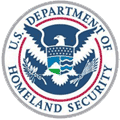United States Department of Homeland Security
|
|
| Established: | November 25, 2002 |
| Activated: | January 24, 2003 |
| Secretary: | Michael Chertoff |
| Deputy Secretary: | Michael P. Jackson |
| Budget: | $36.5 billion (2004) |
| Employees: | 183,000 (2004) |
The United States Department of Homeland Security (DHS) is a Cabinet department of the federal government of the United States that is concerned with protecting America's people from harm and its property from damage. This department was created primarily from a conglomeration of existing federal agencies in response to the terrorist attacks of September 11, 2001.
| Contents |
History
The department was established on November 25, 2002 by the Homeland Security Act and officially began operation on January 24, 2003. After months of discussion about employee rights and benefits and "rider" portions of the bill, Congress passed it shortly after the midterm elections, and it was signed into law by U.S. President George W. Bush. It was intended to consolidate U.S. executive branch organizations related to "homeland security" into a single cabinet agency.
It was the largest government reorganization in 50 years (since the United States Department of Defense was created). The department assumed a number of government functions previously in other departments. It superseded, but did not replace the Office of Homeland Security, which retained an advisory role.
The new Department was initially headed by former governor of Pennsylvania Tom Ridge, who had chaired the Office of Homeland Security since October 2001. On November 30, 2004, Ridge announced his resignation. President Bush chose former NYPD commissioner Bernard Kerik as his successor, but on December 10, Kerik withdrew his nomination citing personal reasons and saying it "would not be in the best interests" of the country for him to pursue the post. On January 11, 2005, President Bush nominated federal judge Michael Chertoff to succeed Ridge. Chertoff was confirmed on February 15, 2005, by a vote of 98-0 in the U.S. Senate. He was sworn in the same day.
Controversy about adoption centered on whether the Federal Bureau of Investigation and the Central Intelligence Agency should be incorporated in part or in whole (both were not). The bill itself was also controversial for the presence of unrelated riders, as well as eliminating some standard civil service and labor protections from employees of the department. President Bush wanted the right to fire an employee within Homeland Security immediately for security reasons, for incompetence, or insubordination. Then-Senate Minority Leader Tom Daschle wanted an appeals process that could take up to 18 months or as little as one month.
On March 12, 2002, the Homeland Security Advisory System, a color-coded terrorism risk advisory scale, was created as a Presidential Directive to provide a "comprehensive and effective means to disseminate information regarding the risk of terrorist acts to Federal, State, and local authorities and to the American people." Many procedures at government facilities are keyed off of the alert level; for example a facility may search all entering vehicles when the alert is above a certain level. Since January 2003, it has been administered in coordination with the DHS; it has also been the target of frequent jokes and ridicule about its perceived ineffectiveness.
Grants
The Department of Homeland Security occasionally gives grants to universities and corporations for developing technologies which could be useful for its activities. For example, in February 2005 a team of researchers from the University of California, Riverside (UCR) and Lucent Technologies received a US$800,000 grant from the US Department of Homeland Security to evaluate modern data-mining methods for discovering behaviour patterns which could be a threat to the national security of the United States of America.
- More information about the grant to UCR and Lucent (http://portal.wikinerds.org/ucr-datamining-dhs)
Organization
- Office of the Secretary
- Office of State and Local Government Coordination and Preparedness
- U.S. Citizenship and Immigration Services
- Directorate of Border and Transportation Security
- Directorate of Emergency Preparedness and Response
- Directorate of Information Analysis and Infrastructure Protection
- Directorate of Science and Technology
- U.S. Coast Guard
- U.S. Secret Service
Related legislation
- 2002 - Homeland Security Act (PL 107-296)
- 2003 - Homeland Security Appropriations Act of 2004 (PL 108-90)
See also
- United States Visitor and Immigrant Status Indicator Technology (US-VISIT)
- U.S. House Committee on Homeland Security
External links
- United States Department of Homeland Security (http://www.dhs.gov/)
- U.S. House Committee on Homeland Security homepage (http://hsc.house.gov/index.cfm)
- The White House - Homeland Security (http://www.whitehouse.gov/homeland)
- ANSI Homeland Security Standards Panel (http://www.ansi.org/standards_activities/standards_boards_panels/hssp/overview.aspx?menuid=3) (ANSI-HSSP)
- DHS website to promote readiness to defend against attack (http://www.ready.gov/)
| United States Federal Executive Departments | Missing image Flag_of_the_United_States.png Flag of the United States |
|---|---|
| State | Treasury | Defense | Justice | Interior | Agriculture | Commerce | Labor | Health and Human Services | Housing and Urban Development | Transportation | Energy | Education | Veterans Affairs | Homeland Security | |
fr:Département_de_la_Défense ja:アメリカ国土安全保障省 nl:Department of Homeland Security no:Sikkerhetsdepartementet (USA) pl:Department of Homeland Security


